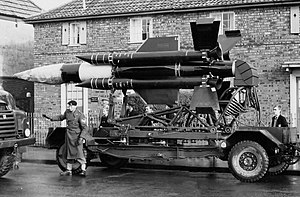English Electric Thunderbird
| Thunderbird | |
|---|---|

Thunderbird I parked at Filton, UK, following a tow vehicle breakdown (1960)
|
|
| Type | ground to air missile |
| Place of origin | UK |
| Service history | |
| Used by | British Army |
| Production history | |
| Manufacturer | English Electric |
| Specifications | |
| Length | 20 ft 10 in (6.35 m) |
| Diameter | 1 ft 8.7 in (0.527 m) |
| Warhead | Continuous-rod HE warhead |
|
|
|
| Wingspan | 5 ft 4 in (1.63 m) |
| Speed | mach 2.7 |
|
Guidance
system |
semi-active radar homing |
|
Launch
platform |
Single rail, ground mounted (not mobile) |
The English Electric Thunderbird was a British surface-to-air missile produced for the British Army. Thunderbird was primarily intended to attack higher altitude targets at ranges up to approximately 30 miles, providing wide-area air defence for the Army in the field. AA guns were still used for lower altitude threats. Thunderbird entered service in 1959 and underwent a major mid-life upgrade to Thunderbird 2 in 1966, before being slowly phased out by 1977. Ex-Army Thunderbird I's were also operated by the Royal Saudi Air Force after 1967.
Thunderbird had performance similar to other semi-portable missiles like the US MIM-23 Hawk and fully mobile Soviet 2K11 Krug, although it pre-dates both of these systems and offered greater range over them, but have slower speed compared to the soviet 2K11 Krug. After its mid-life upgrades, which shared several components with the RAF's Bristol Bloodhound, Thunderbird featured a continuous-wave radar semi-active homing system that was highly resistant to Radar jamming and deception, and was able to track targets even at very low altitudes.
Thunderbird was the Army's only heavy anti-aircraft missile. As missile systems like Thunderbird made flight at medium and higher altitudes practically suicidal, nap-of-the-earth flying became the norm and even shorter-range, faster acting systems were needed. Thunderbird's role was taken over by the much smaller BAC Rapier as they became available.
The Thunderbird originated in a proposal to English Electric in 1949 to develop a missile to provide ground based air defence to the British Army in the field. As such, it was intended to replace the 3.7-inch heavy anti-aircraft gun that fulfilled this role during World War II. Like the 3.7, the new missile would be operated by the Royal Artillery. English Electric created a Guided Weapons Division to work on the project.
...
Wikipedia
